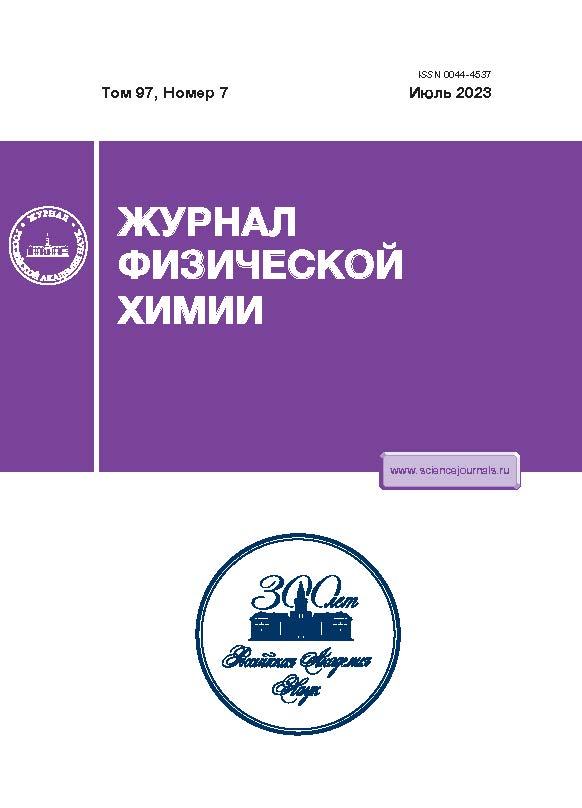Mechanism for the Formation of Nanoscale Oxides in a Medium of Supercritical CO2 Fluid
- Авторлар: Golubev D.V.1, Sigov A.S.1, Kolobanov A.I.1, Fomichev V.V.1
-
Мекемелер:
- Russian Technological University (MIREA)
- Шығарылым: Том 97, № 7 (2023)
- Беттер: 1038-1044
- Бөлім: PHYSICAL CHEMISTRY OF NANOCLUSTERS, SUPRAMOLECULAR STRUCTURES, AND NANOMATERIALS
- ##submission.dateSubmitted##: 27.02.2025
- ##submission.datePublished##: 01.07.2023
- URL: https://rjonco.com/0044-4537/article/view/668704
- DOI: https://doi.org/10.31857/S0044453723070117
- EDN: https://elibrary.ru/SKRHQM
- ID: 668704
Дәйексөз келтіру
Аннотация
A possible mechanism is considered for the formation of nanoscale oxides based on titanium and aluminum isopropoxides in a medium of supercritical CO2 fluid. It is shown that because of intermolecular interactions and high pressure in the system, the supercritical fluid acquires the properties of a condensed medium, the main role of which is to restrain processes of hydrolysis. At the first stage of the hydrolysis of titanium isopropoxide, the water molecule is coordinated in the outer sphere of the central atom due to the formation of intermolecular hydrogen bonds. It is then coordinated into the inner sphere with the formation of a five-coordinate transition state and its destruction, creating a product substituted for the hydroxo group. The next steps proceed in a similar way. The described mechanism agrees with experimental findings and produces nanosized X-ray amorphous titanium oxide. (With aluminum isopropoxide, only the hydrolyzed hydroxo form can be produced.) Results suggest the production of nanosized oxides from isopropoxides in a medium of supercritical CO2 fluid is possible for transitional d-elements.
Авторлар туралы
D. Golubev
Russian Technological University (MIREA)
Email: valeryfom@rambler.ru
119454, Moscow, Russia
A. Sigov
Russian Technological University (MIREA)
Email: valeryfom@rambler.ru
119454, Moscow, Russia
A. Kolobanov
Russian Technological University (MIREA)
Email: valeryfom@rambler.ru
119454, Moscow, Russia
V. Fomichev
Russian Technological University (MIREA)
Хат алмасуға жауапты Автор.
Email: valeryfom@rambler.ru
119454, Moscow, Russia
Әдебиет тізімі
- Воробей А.М., Покровский О.И., Устинович К.Б. и др. // Сверхкритические флюиды: теория и практика. 2015. Т. 10. № 2. С. 51–59.
- Lemasson E., Bertin S., West C. // J. of Separation Science. 2016. V. 39. № 1. P. 212. https://doi.org/10.1002/jssc.201501062
- Gomes P.B., Mata V.G., Rodrigues A.E. // The J. of Supercritical Fluids. 2007. V. 41. № 1. P. 50. https://doi.org/10.1016/j.supflu.2006.08.018
- King J.W. // Annual Review of Food Science and Technology. 2014. V. 5. № 1. P. 215. https://doi.org/10.1146/annurev-food-030713-092447
- Kaleva A., Heinonen S., Nikkanen J.P., Levänen E. // IOP Conference Series: Materials Science and Engineering. 2017. V. 175. № 1. P. 120. https://doi.org/10.1088/1757-899X/175/1/012034
- Da Silva E.P., Guilherme M.R., Tenório-Neto E.T. et al. // Materials Letters. 2015. V. 136. P. 133 https://doi.org/10.1016/j.matlet.2014.07.156
- Zhu C., Zhou Y., Fu S. et al. // ECS Transactions. 2015. V. 69. № 17. P. 631. https://doi.org/10.1149/06917.0631ecst
- Kim D.S., Shin Y.H., Lee Y.W. // Chemical Engineering Communications. 2015. V. 202. № 1. P. 78. https://doi.org/10.1080/00986445.2013.825611
- Permana A.D.C., Nugroho A., Chung K.Y. et al. // Chemical Engineering Journal. 2014. V. 241. P. 216. https://doi.org/10.1016/j.cej.2013.12.029
- Кузьмичева Г.М. Тонкие химические технологии. 2015. Т. 10. № 6. С. 5.
- Alekseev E.S., Alentiev A.Y., Belova A.S. et al. // Russ. Chem. Rev. 2020. V. 89. P. 1337. https://doi.org/10.1070/RCR4932?locatt=label:RUSSIAN
- Коновалов И.А., Маврин Б.Н., Прокудина Н.А. и др. Изв. академии наук. Серия Химическая. 2016. № 12. С. 2795.
- Смирнова К.А., Фомичев В.В., Дробот Д.В. и др. Тонкие химические технологии. 2015. Т. 10. № 1. С. 76.
- Sokolov I.E., Konovalov I.A., Zakalyukin R.M. et al. MRS communication. 2018. V. 8. № 1. P. 59. https://doi.org/10.1557/mrc.2018.3
- Oskam G., Nellore A., Penn R.L. et al. // J. Phys. Chem. B. 2003. V. 107. P. 1734. https://doi.org/10.1021/jp021237f
- Park Jin-Koo, Myoung Jung-Jae, Kyong Jin-Burm et al. // Bull. Korean Chem. Soc. 2003. V. 24. № 5. P. 671. https://doi.org/10.5012/bkcs.2003.24.5.671
- Zhang Y., Yang J., Yu Y.-X. // The Journal of Physical Chemistry B. 2005. V. 109. № 27. P. 133575. https://doi.org/10.1021/jp045741r
- Teymourtash A.R., Khonakdar D.R., Raveshi M.R. // The of Supercritical Fluids. 2013. V. 74. P. 115. https://doi.org/10.1016/j.supflu.2012.12.010
- Lebedev A.E., Katalevich A.M., Menshutina N.V. // J. of Supercritical Fluids. 2015. V. 106. P.122. https://doi.org/10.1016/j.supflu.2015.06.010
- Borjan D., Gracnar M., Knez Z. et al. // Processes. 2022. V. 10. P. 2275. https://doi.org/10.3390/pr10112275
- Pierotti R.A. // Chem. Rev. 1976. V. 76. P. 717. https://doi.org/10.1021/cr60304a002
- Emsley J. The Elements, third ed. Oxford: Oxford University Press, 1998.
- Barca G.M.J., Bertoni C., Carrington L. et al. // J. Chem. Phys. 2020. V. 152. P. 154102. https://doi.org/10.1063/5.0005188
- Adamo C. // J. Chem. Phys. 1999. V. 110. P. 6158. https://doi.org/10.1063/1.478522
Қосымша файлдар














